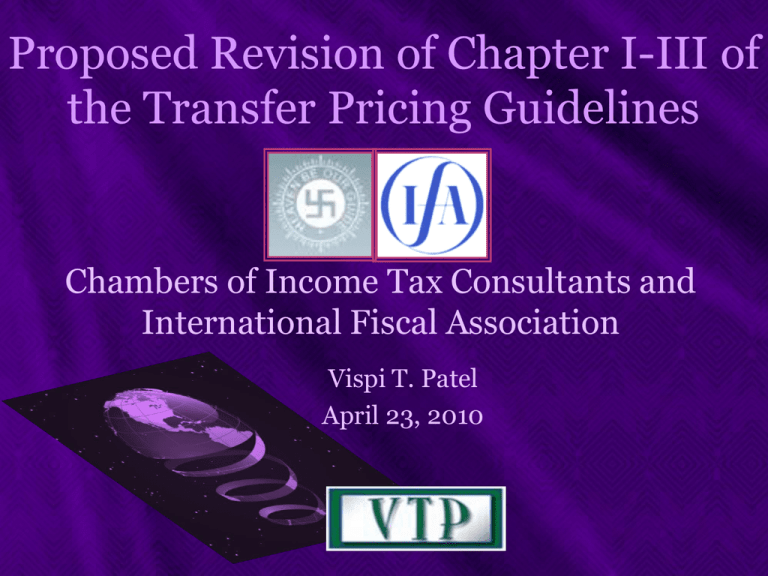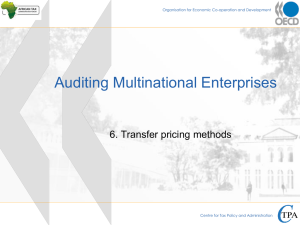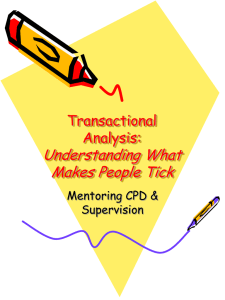Proposed Revision of Chapter - 1 - 3 of the Transfer Pricing Guidelines
advertisement

Proposed Revision of Chapter I-III of the Transfer Pricing Guidelines Chambers of Income Tax Consultants and International Fiscal Association Vispi T. Patel April 23, 2010 Agenda Introduction Purpose of Revision Changes in Arm’s Length Principle Changes in Methods Changes in Comparability Introduction Last 15 years experience Taxpayers concerned about lack of consistency as regards interpretation of the TP Guidelines Results in risk of double taxation, because two administrative authorities can apply the arm’s length standard inconsistently Domestic law of many countries may have nuances in their Transfer Pricing Regulations which could be different from the TP Guidelines Introduction ….. Last 15 years experience (contd.) Thus, there is a need for the Transfer Pricing Regulations to be more explanatory than directory or mandatory There is a need for the Transfer Pricing Regulations to be more flexible to absorb the vicissitudes of business and commerce There is a need to recognize that Economic forces are dynamic and hence Transfer Pricing cannot be a rigid standard and is thus an ‘Art’ of amalgamation of Science, Economics and Law Agenda Introduction Purpose of Revision Changes in Arm’s Length Principle Changes in Methods Changes in Comparability Purpose of Revision Proposed revision aims to bring more flexibility in application of the arm’s length standard and The Arm’s Length Standard is based on Comparability Applying the Methods To Evaluate whether controlled transaction is at arm’s length Purpose of Revision ….. The proposed revision achieves this flexibility broadly by: Affording Transactional Profit based Methods equal status (almost) to Transaction Based Methods Practical experience of the last decade and a half clearly show that profit based methods are employed by the taxpayers and tax administration due to lack of availability of data in public domain at transaction level Broadening the section of comparability as it addresses many concerns of the taxpayers and the tax administration Agenda Introduction Purpose of Revision Changes in Arm’s Length Principle Changes in Methods Changes in Comparability Changes in Arm’s Length Principle There is an emphasis that at the heart of the ALP is the comparable analysis of the conditions between the controlled and comparable uncontrolled transactions Comparability is on conditions prevalent between controlled and uncontrolled transactions including price but not limited to price alone Comparable analysis will determine whether adjustment is required to the controlled transaction or not Changes in Arm’s Length Principle….. Acceptance that controlled entities may enter into transactions which are unique and for which comparable uncontrolled transactions may not be available, this does not imply that the transactions are not at arm’s length The aim is to have a balanced approach as regards the burden of evaluating host of comparable information and the goal is to have reasonably reliable comparables Agenda Introduction Purpose of Revision Changes in Arm’s Length Principle Changes in Methods Changes in Comparability Changes in Methods Selection of the most appropriate transfer pricing method to the circumstances of the case No one method can be applied to every possible situation The selection of a transfer pricing method always aims at finding the most appropriate method for a particular case Applicability of any particular method need not be disproved Though all methods are philosophically on the same plane, one can still feel the strong undercurrent for preference of Traditional Transactional Methods, especially CUP Transactional Profit Split Method – Determination of Combined Profit to be Split Determination of the combined profit to be split and splitting factors should be consistent with the functional analysis and allocation of the risks among the parties, based on the factors agreeable to the independent parties, consistent with the type of profit split approach and be capable of being measured in reliable manner Transactional Profit Split Method – Determination of Combined Profit to be Split….. The combined profit to be split (including losses) should only be that profit arising from the controlled transaction(s) under review In order to determine the combined profit to be split, the accounts of the parties to the transaction to which transactional profit split is applied needs to be put on a common basis as to accounting practice and currency, and then combined. Accounting standards should be selected in advance of applying the method, should be documented and applied consistently over the lifetime of the arrangement Transactional Profit Split Method – How to split the combined profit? The criteria or allocation keys used to split the profit should be reasonably independent of the transfer pricing policy formulation and should be supported reasonably by reliable comparable data, internal data, or both In practice, common allocation keys are based on assets / capital (operating assets, fixed assets, intangible assets, capital employed) or costs (relative spending and / or investment in key areas such as research and development, engineering, marketing). Other allocation keys can be based on incremental sales, headcounts, time spent by certain group of employees, number of servers, data storage, floor space, etc. Transactional Profit Split Method – How to split the combined profit?..... Asset base or capital based allocation can be used where there is a strong correlation between tangible or intangible assets or capital employed and creation of value in context of the controlled transaction Cost based allocation can be used where there is a strong correlation between relative expenses incurred and relative value added Transactional Profit Split Method Implications The revised guidance on application makes it more practical and has a more realistic approach The availability of comparable data in public domain to apply various allocation keys is the inherent limitation of the method, which the proposed revision tries to mitigate by even considering internal data based on FAR analysis which accounts for contribution by the AEs Transactional Net Margin Method – Determination of the Net Profit Margin Only those items that directly or indirectly relate to the controlled transaction at hand and are of an operating nature should influence the determination of the net profit margin for application of TNMM Non Operating items such as income tax should be excluded from the determination of the net profit margin indicator. Exceptional and extraordinary items of a non-recurring nature should generally also should be excluded Transactional Net Margin Method – Determination of the Net Profit Margin….. Whether interest income and expenses emanate from the operations of the enterprise and hence form part of operating profit or not, is dependent on the functional analysis of the enterprise and is fact driven Foreign Exchange Gains and Losses should be included or excluded from determination of the net profit margin depends upon whether they are of a trading nature and who undertakes the forex risk Transactional Net Margin Method – Determination of the Net Profit Margin….. Whether start-up costs and termination costs should be included in the determination of the net profit margin indicator depends on the facts and circumstances of the case and on whether in comparable circumstances, independent parties at arm’s length would have agreed either for the party performing the function to bear the start-up costs and possible termination costs; or for part or all of these costs to be recharged with no mark-up Transactional Net Margin Method – Weighing the Net Margin The selection of the denominator should be consistent with the comparability (including functional) analysis of the controlled transaction, and in particular it should reflect the allocation of risks between the parties. Such indicator might need to be required to be adjusted depending on what party to the controlled transaction bears that risk, as well as on the degree of differences in the risk that may be found in the taxpayer’s controlled transaction and in comparables Transactional Net Margin Method – Weighing the Net Margin….. The denominator should also be focused on relevant indicator(s) as demonstrated by functional analysis The denominator should be reasonably independent of the controlled transaction Denominator should be one that is capable of being measured in a reasonably reliable and consistent manner at the level of the taxpayer’s controlled transaction Transactional Net Margin Method – Weighing the Net Margin (Indicators) Net Profit weighted to sales – Sometimes used to determine the ALP of purchases from a related party for resale to third party customers Net Profit weighted to costs – Should be used in cases where costs are a relevant indicator of the functional and economic business model of the tested party. The cost base used should be a reflection of the controlled transactions that are evaluated Transactional Net Margin Method – Weighing the Net Margin (Indicators)….. Net Profit weighted to assets – Return on assets can be an appropriate base in cases where assets (rather than cost or sales) are a better indicator of the value added and risk undertaken by the tested party Berry Ratios – Defined as ratios of gross profit to operating expenses. Interest and extraneous income would be included depending upon the nature of the business; depreciation and amortization may or may not be included in the operating expenses, depending in particular on the possibilities of uncertainties they can create in relation to valuation and comparability Transactional Net Margin Method Implications The detailed guidance on application of TNMM will be a practical aid for the taxpayer and the tax administration The importance of the determination of the profit to be tested is critical Transactional Net Margin Method – Implications….. The application of TNMM is founded on comparing profitability ratios of comparable uncontrolled transactions with that of the controlled transactions, hence the correct selection and application of the ratios is of utmost importance The economic analysis and the business model would determine the methodology of margin computation and the nuance of pass-through costs used in TP analysis has been correctly recognized Agenda Introduction Purpose of Revision Changes in Arm’s Length Principle Changes in Methods Changes in Comparability Comparability Analysis While selection of a cost plus, resale price or transactional net margin method, it is necessary to choose the party to the transaction for which the financial indicator is tested. The choice of the tested party should be consistent with the functional analysis of the transaction. The tested party is the one to which has the least complex functional analysis Comparability Analysis….. The complete search process identifying potentially comparable uncontrolled transactions and their link to the functional analysis and to the ultimate conclusion of the benchmarking process is at the very heart of the TP analysis and consequently in determining the ALP Profit based methods should in no case cast an additional burden merely because the enterprise is less successful and conversely successful enterprises should not be charged less tax, as success or lack thereof is based on economic and commercial factors and not on TP analysis alone Comparable Uncontrolled Transactions A comparable uncontrolled transaction is a transaction between two unrelated parties that is comparable to the controlled transaction under examination. It can either be internal comparable or external comparable. Comparison of the taxpayer’s controlled transactions with such other controlled transactions are irrelevant to the application of the arm’s length principle and therefore should not be used by a tax administration as the basis for the transfer pricing adjustment or by the taxpayer to support its transfer pricing policy Use of commercial database for identifying external comparable uncontrolled transactions should not encourage quantity over quality Comparability Adjustments The most commonly observed adjustments, especially while using the transactional net margin method, are balance sheet or asset intensity adjustments. Other type of adjustment including accounting adjustment that are aimed at dealing with differences in accounting standards or classification of income and expenses; adjustments for differences in contractual terms, etc. Comparability adjustments should be considered where (and only where) they can be expected to increase the reliability of the results Comparability Adjustments….. Data from years following the year of the transaction may also be relevant to the analysis of transfer prices, but care must be taken to avoid the use of hindsight Examining multiple year data is often useful in comparability analysis, but it is not a systematic requirement. Multiple year data should be used where it adds value to the transfer pricing analysis Vispi T. Patel & Associates #10, Dwarka Ashish, Jambul Wadi, Opp. Edward Cinema, Kalbadevi Road, Marine Lines, Mumbai – 400 002 Contact No.: +91 22 2208 4605 / 7742 +91 98676 35555 Thank You Email: vispitpatel@vispitpatel.com Questions








